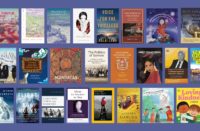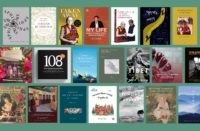
High Peaks Pure Earth, in a cross-post with LA Review of Books China Channel, presents the seminal 1983 Tibetan poem Waterfall of Youth by Dondrup Gyal in a new English translation by Lowell Cook.
This post concludes the China Channel’s Tibetan Poetry Week which saw Palden Gyal introduce and present translations of Theurang’s prison poetry and Lowell Cook review “Burning the Sun’s Braids”, a collection of poems from Tibet in translation by Bhuchung D. Sonam.
“Waterfall of Youth”
A seminal Tibetan poem, in a new translation by Lowell Cook
The tragic yet prolific life of Dondrup Gyal (1953-1985) was one of foremost catalysts for the birth of modern literature in Tibet. Having grown up during the Cultural Revolution, Dondrup Gyal was one of the first Tibetans to attend Chinese universities in the opening-up and reform era. Not only did studying with renown Tibetan and Chinese scholars at the Central Nationalities Institute in Beijing hone his writings skills and give him access to a new world of literature, it also shaped his progressive vision for the Tibetans. It was this combination of literary skill and innovative thinking that Gyal would soon become famous for. Unfortunately, his progressive views also made him a target for criticism and ostracization in the highly conservative Tibetan society of the day. This, in addition to strained relationships with colleagues, local officials, and his wife Yumkyi, contributed to his suicide in 1985 at the age of 32. Despite Gyal’s short life, his collected works contain six volumes of poetry, fiction and essays.
Written under his penname, Rangdrol (“self-liberated”), ‘Waterfall of Youth’, written in 1983, is said to be the first free-verse poem written in Tibetan. To be sure, the 11th century Songs of Milarepa, and other Tibetan folk literature, may equally constitute free-verse poetry. Yet the form and content of Waterfall of Youth are notably unique and innovative.
The form of the poem is that of a waterfall. As you read down the page, you can see the sometimes gentle, sometimes violent flow as the waterfall of youth visually cascades down the page. The cadence of the lines is also reminiscent of the flow of a waterfall or the current of a river. This form would have previously been most difficult to capture in Tibetan, given that the majority of books were written or printed on long, narrow rectangular manuscripts. Likewise, the use of non-native punctuation – ellipses and em dashes – is arguably one of the very first such instances in Tibetan literature.
Despite this radically new form, much of the content echoes the Tibetan literature of old. We can see the influences of Indic aesthetics that have so deeply impacted Tibetan literature, with deities like Indra and Sarasvasti and animals like elephants and peacocks. At the same time, political slogans of the day are also referenced with the words “conservatism”, “blind faith”, “backwardness” and so forth – all words newly created by communist translation efforts. This blending of tradition and innovation, Buddhist and political terminology, is what has made ‘Waterfall of Youth’ a timeless poem for Tibetans. Its legacy is constantly being reinterpreted: the poem has been turned into a rap song by Tibet’s hip-hop artist Dekyi Tsering, and numerous parodies have been composed, such as ‘Waterfall of Beer.’
To date, there are two existing English translations – one by the historian Tsering Shakya, and the other by the late Tsering D. Gonkatsang. Both of these translations leave much to be desired, as Shakya’s translation occasionally omits lines and Gonkatsang’s seems to forgo the waterfall stylized formatting. The below translation aims to capture the poem’s tone and resonance while presenting Dondrup Gyal’s original vision. May the waterfall continue to flow!
Waterfall of Youth (1983)
by Rangdrol (Dondrup Gyal)
Translated by Lowell Cook*
The sky, blue and clear
Sunlight, warm and gentle
Earth, vast and wide
Flowers, beautiful and charming
Mountains, high and mighty… …
Ema—
Yet what’s even more wonderful still
is this waterfall, cascading
off the steep cliff face, right in front us
Look!
It’s bubbly waves, pure and pristine
With spheres of light, the eyes of a peacock feather
the tuft of a parrot
patterns of silk brocade
the rainbow-like bow of Indra [1]
Listen!
The sound of it’s current, clear and euphonic
the melody of youth, the songs of the gandarvas [2]
the voice of Brahma
the voice of Sarasvasti
the tune of the cuckoo
Kye—this is not an ordinary, natural waterfall, no
a mighty and majestic expression
a fearless heart
undaunted courage
flourishing and thriving body
elegant and lavish adornments
pleasant and beautiful songs
This is—
the waterfall of youth, the youth of snowy Tibet
This is—
the courage to be creative
the expressions of struggle
the music of youth
within the Tibetan youth of the nineteen-eighties
Kye! Kye! Ah, youthful waterfall
waterfall of youth
How did such fearless courage
—undaunted self-confidence
—unimpaired splendor
—and inexhaustible strength blossom within you?
Indeed,
the rains falling from the heavens during the three months of spring
the springs gushing forth from the earth during the three months of summer
the essence of frost and hail during the three months of autumn
the quintessence of the ice and snow during the three months of winters
and yet still
glacial water—mineral water—slate water—water from forests
marshes—mountains—valleys—ravines—and gullies
In brief,
—water of auspiciousness
—water of goodness
—water of wishes fulfilled
—water with the eight qualities [3]
—water of abundance
One hundred and eight different rivulets
Hundreds of thousands of different types of water
As you are the one river of their unity
You dare to cascade of craggy precipices
As you are the one river that gathers them all
You are brave enough to jump off cliffs into gorges
With your courage to collect the different waters of innovation
Your intellect is vast, your body strong, and your splendor great
With your lack of arrogance and freedom from conceit
Your flow is long and current fierce
As you have removed impurities and possess the capacity to extract the quintessence
Your body and mind be pure while the glories qualities of your youth flourish
O waterfall,
You are the witness to history
You are the guide to the future
Within each of your crystal clear drops of water
The highs and lows of snowy Tibet are inscribed
And inside each droplet of your spray
The rise and fall of the cool land of snows are contained
Without you,
How are we to temper the steel of the sword of grammar?
Without you,
How are we to sharpen the razor of craftsmanship?
Without you,
The tree of medicine cannot flourish,
The flowers of logic and fruit of the inner sciences cannot possibly ripen
Perhaps—
Within this crystal-like mind of yours
The wounds of history
The ailments of battle
The boils of blind faith
And the dust of conservatism might possibly be found
Nevertheless,
Since you possess the majesty of youth and naturally present glory
The frost of the three months of winter will never
—have a chance to place your mind within the recess of glaciers
The razor blazes of stormy winds might slash
—your stream a hundred times, yet how could it ever actually be severed?
The reason—
The head of your river is linked with the snows
And your river’s mouth mixes with the oceans
Thus, your long flow of history
Has granted us splendor and honor
The beautiful sound of the flow of your generations
Has granted us encouragement and strength
Have your heard—O waterfall!
Of these questions of the youth of snowy Tibet?
When the stallion of poetry is suffering of thirst, what shall we do?
When the elephant of composition is suffering of heat, what shall we do?
When the lion of poetic synonyms is oppressed by malevolence, what shall we do?
When the young child of drama is left behind as an orphan, how shall we take care of him?
When the paternal inheritance of astrology is left behind empty, who will uphold it?
When the young man of science is taken as a groom, how will he be welcomed?
When the daughter of craftsmanship is taken as a bride, who will be the husband?
Yes, indeed—O waterfall!
Your answers which come from music, clear and pristine, beautiful and charming,
—We hold in our hearts, like an image carved in stone
Surely
It is not suitable for the past that blazed with thousand brilliant lights to substitute the present
And how could yesterday with its taste of salt ever quench the thirst of today?
When the life-force that is ripe for the times
Does not fit the lifeless corpse of history difficult to find,
It’s impossible for the pulse of improvement to beat
And the heart blood of advancement can not flow
Even more so are the steps on the way forward
Hey, waterfall!
From your waves shimmering and glistening
And from your spray scattering to and fro—
Our strength
—The strength of the new generation of snowy Tibet has been symbolized
From your gurgling, flowing current,
And the bubbling sound of your flowing water
Our dreams,
—the dreams the new generation of snowy Tibet, are manifest
Conservatism, cowardice, blind faith, and laziness… …
These have no place whatsoever in this generation of ours
Backwardness, barbarian, darkness, backward customs… …
There is no room, whatsoever, for these in our century
Waterfall, O waterfall!
Our mind flows with your movement and
Our blood as well, courses alongside your currents
Although on the path of the future
The twists and turns may be greater than before,
Nevertheless, there is no chance for the youth of Tibet to be afraid
We will certainly forge a new path forward
For each and everyone of our people
Look!
The squadron lined up, those are the new generation of Tibet
Listen!
This steady song is the footsteps of the youth of snowy Tibet
A great, luminous path
Responsibility with glory
Joyful livelihoods
Songs of struggle
Have not vanished within the youth of the waterfall,
And even more so, the waterfall of youth does not decline
This—
This is the waterfall of youth emerging from the voices of the young generations of snowy Tibet!
This—
The waterfall of youth flowing in the mind of the youth of snowy Tibet
Notes:
[1] The bow of Indra (dbang po’i gzhu or brgya byin gzhu) is a poetic synonym for a rainbow.
[2] The gandarvas are a class of being in the Indo-Tibetan cosmology that are said to be the musicians of the god realms.
[3] Water possessing the eight qualities is traditionally said to be sweet, cool, smooth, light, clear, pure, soothing to the throat, and beneficial to the stomach.
*Lowell Cook studied Tibetan in Kathmandu, currently lives in Chengdu and translates Tibetan literature





Great work! Appreciate brother!
Beautiful! Thank you.